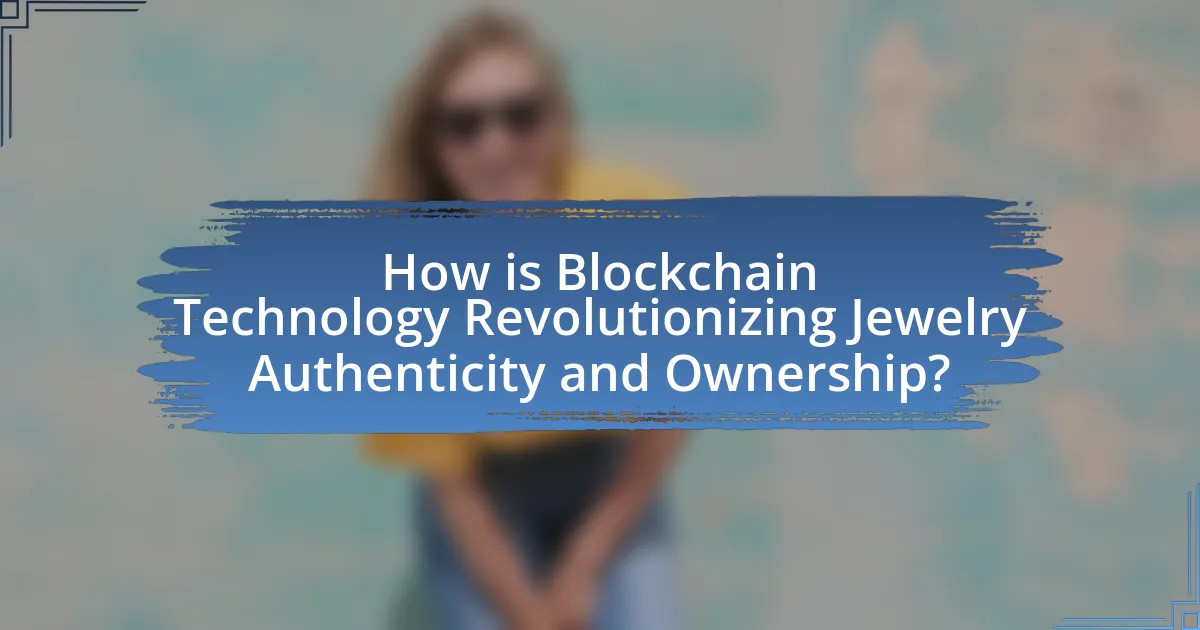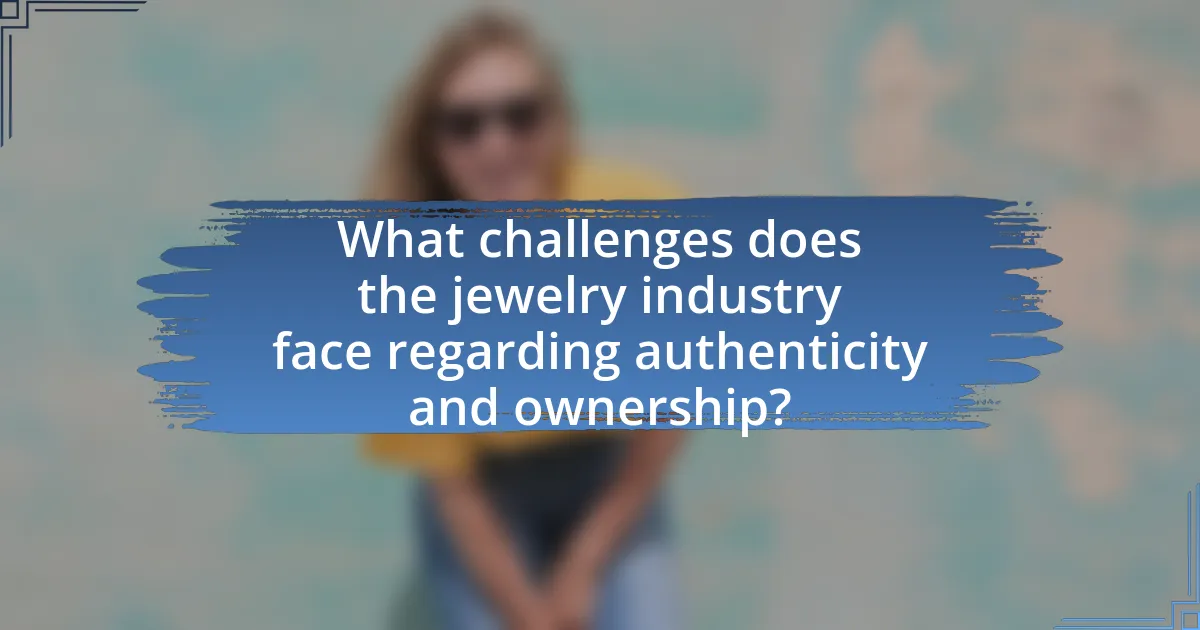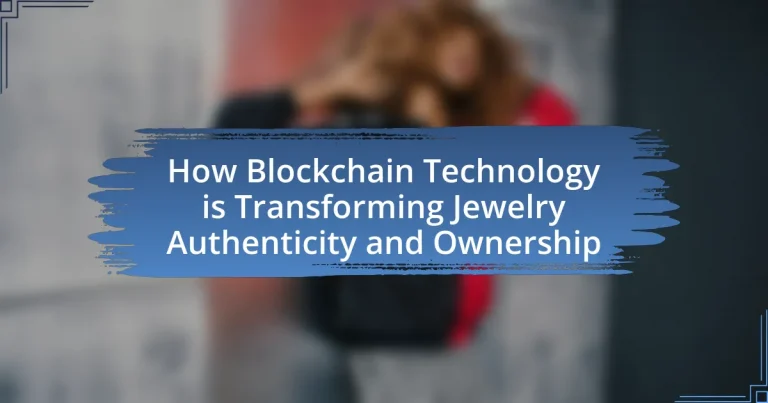Blockchain technology is fundamentally transforming the jewelry industry by enhancing authenticity and ownership verification through a secure, transparent, and immutable ledger system. This technology allows consumers and retailers to trace the provenance of jewelry items, ensuring that gemstones and precious metals are genuine and ethically sourced. Key features such as immutability, transparency, and decentralization significantly reduce the risk of fraud and counterfeiting, while also improving consumer trust and brand integrity. The article explores the challenges faced by the jewelry industry regarding authenticity, the prevalence of counterfeit products, and the financial implications for retailers, alongside the practical steps for implementing blockchain solutions in the supply chain.

How is Blockchain Technology Revolutionizing Jewelry Authenticity and Ownership?
Blockchain technology is revolutionizing jewelry authenticity and ownership by providing a secure, transparent, and immutable ledger for tracking the provenance of jewelry items. This technology enables consumers and retailers to verify the authenticity of gemstones and precious metals through a decentralized system that records every transaction and ownership change. For instance, companies like Everledger utilize blockchain to create digital certificates for diamonds, ensuring that each stone’s history, including its origin and ownership, is permanently recorded and easily accessible. This not only enhances consumer trust but also helps combat fraud and unethical sourcing in the jewelry industry, as verified data can be traced back to the mine or manufacturer.
What are the key features of blockchain technology that enhance jewelry authenticity?
The key features of blockchain technology that enhance jewelry authenticity include immutability, transparency, and traceability. Immutability ensures that once data about a piece of jewelry is recorded on the blockchain, it cannot be altered or deleted, providing a permanent record of authenticity. Transparency allows all stakeholders, including manufacturers, retailers, and consumers, to access the same information regarding the jewelry’s origin and ownership history, fostering trust. Traceability enables the tracking of a jewelry item from its source through the supply chain, confirming its authenticity and ethical sourcing. These features collectively ensure that consumers can verify the authenticity of their jewelry with confidence, as supported by studies indicating that blockchain can reduce fraud in luxury goods by up to 30%.
How does decentralization contribute to the security of jewelry ownership records?
Decentralization enhances the security of jewelry ownership records by distributing data across multiple nodes rather than storing it in a single, centralized location. This distribution minimizes the risk of data tampering or loss, as altering records would require consensus across the entire network, making unauthorized changes significantly more difficult. Furthermore, blockchain technology, which underpins decentralization, employs cryptographic techniques to secure transactions and ownership records, ensuring that only authorized parties can access or modify the information. The immutable nature of blockchain records means that once ownership is recorded, it cannot be altered without detection, providing a reliable and transparent history of ownership.
What role does immutability play in verifying jewelry authenticity?
Immutability plays a crucial role in verifying jewelry authenticity by ensuring that once information about a piece of jewelry is recorded on a blockchain, it cannot be altered or deleted. This characteristic of blockchain technology provides a permanent and tamper-proof record of ownership, provenance, and certification details, which are essential for establishing authenticity. For instance, when a jewelry item is registered on a blockchain, its unique identifiers, such as serial numbers and certification data, are securely stored, allowing stakeholders to trace its history without the risk of forgery or manipulation. This reliability is supported by the decentralized nature of blockchain, where multiple copies of the data exist across a network, making it nearly impossible for any single entity to alter the information without consensus from the network.
Why is jewelry authenticity important for consumers and retailers?
Jewelry authenticity is crucial for consumers and retailers because it ensures the value and quality of the products being bought and sold. For consumers, authentic jewelry guarantees that they are receiving genuine materials, such as gold or diamonds, which directly affects the item’s worth and longevity. Retailers benefit from authenticity as it builds trust with customers, enhances brand reputation, and reduces the risk of counterfeit products that can lead to financial losses. According to a report by the Gemological Institute of America, the presence of counterfeit jewelry can undermine consumer confidence and negatively impact the entire market. Thus, authenticity serves as a foundation for both consumer satisfaction and retailer integrity in the jewelry industry.
How does authenticity impact consumer trust in the jewelry market?
Authenticity significantly enhances consumer trust in the jewelry market by assuring buyers of the quality and origin of their purchases. When consumers can verify that a piece of jewelry is genuine, they are more likely to feel confident in their investment, leading to increased satisfaction and loyalty. Research indicates that 70% of consumers are willing to pay more for products they perceive as authentic, highlighting the direct correlation between authenticity and consumer willingness to invest in jewelry. Furthermore, the implementation of blockchain technology provides a transparent and immutable record of a jewelry item’s provenance, further solidifying trust by allowing consumers to trace the history and authenticity of their purchases.
What are the financial implications of counterfeit jewelry for retailers?
Counterfeit jewelry significantly impacts retailers financially by leading to revenue loss, increased operational costs, and damage to brand reputation. Retailers face direct revenue loss when counterfeit products are sold instead of authentic items, which can result in a decrease in sales and market share. According to a report by the International Chamber of Commerce, the global economic impact of counterfeiting and piracy is estimated to reach $4.2 trillion by 2022, affecting various sectors, including jewelry. Additionally, retailers incur higher operational costs due to the need for enhanced security measures, legal actions against counterfeiters, and potential refunds or returns from dissatisfied customers. The presence of counterfeit goods can also erode consumer trust, leading to long-term damage to brand reputation and customer loyalty, which further exacerbates financial losses.

What challenges does the jewelry industry face regarding authenticity and ownership?
The jewelry industry faces significant challenges regarding authenticity and ownership, primarily due to the prevalence of counterfeit products and lack of transparent provenance. Counterfeit jewelry can undermine consumer trust and brand integrity, with estimates suggesting that the global counterfeit jewelry market is worth billions, impacting legitimate businesses. Additionally, the absence of a reliable system to verify the origin of materials, such as diamonds and precious metals, complicates ownership claims and raises ethical concerns about sourcing. These issues highlight the need for innovative solutions, such as blockchain technology, which can provide immutable records of authenticity and ownership, thereby addressing these challenges effectively.
How prevalent is counterfeit jewelry in the market?
Counterfeit jewelry is highly prevalent in the market, with estimates suggesting that around 30% of all jewelry sold online may be counterfeit. This significant figure highlights the widespread issue of imitation products, particularly in the luxury segment, where consumers often face challenges in verifying authenticity. According to a report by the International Chamber of Commerce, the global economic impact of counterfeit goods, including jewelry, is projected to reach $4.2 trillion by 2022, underscoring the scale of the problem.
What are the common methods used to create counterfeit jewelry?
Common methods used to create counterfeit jewelry include the use of imitation materials, such as base metals and synthetic stones, to replicate the appearance of precious metals and gemstones. Counterfeiters often employ techniques like electroplating to coat cheaper metals with a thin layer of gold or silver, making them appear authentic. Additionally, advanced manufacturing methods, such as 3D printing, allow for the precise replication of intricate designs, further deceiving consumers. The prevalence of these methods is supported by industry reports indicating that counterfeit jewelry constitutes a significant portion of the market, with estimates suggesting that the global counterfeit goods market, including jewelry, is worth hundreds of billions of dollars annually.
How do counterfeit products affect brand reputation?
Counterfeit products significantly damage brand reputation by undermining consumer trust and diluting brand value. When consumers encounter counterfeit items, they often associate the poor quality and negative experiences with the legitimate brand, leading to a decline in customer loyalty. According to a report by the International Chamber of Commerce, the global economic impact of counterfeiting is estimated to reach $4.2 trillion by 2022, indicating the scale at which brands are affected. This loss of trust can result in decreased sales and market share, as consumers may choose to avoid brands perceived as compromised. Additionally, brands may incur substantial costs in combating counterfeiting, further straining their resources and reputation.
What are the limitations of traditional methods for verifying jewelry authenticity?
Traditional methods for verifying jewelry authenticity often lack reliability and comprehensiveness. These methods, such as visual inspections, acid tests, and hallmark verification, can be easily manipulated or misinterpreted, leading to potential fraud. For instance, visual inspections depend heavily on the expertise of the appraiser, which can vary significantly, while acid tests can damage the jewelry and only provide limited information about the metal’s purity. Additionally, hallmark verification relies on the presence of stamps that can be forged, making it an unreliable indicator of authenticity. These limitations highlight the need for more secure and transparent verification methods, such as those offered by blockchain technology, which can provide immutable records of authenticity and ownership.
How do paper certificates fall short in ensuring ownership security?
Paper certificates fall short in ensuring ownership security due to their susceptibility to forgery and loss. Unlike digital records, paper certificates can be easily replicated, making it difficult to verify authenticity. Additionally, physical documents can be lost, damaged, or destroyed, leading to disputes over ownership. According to a study by the International Journal of Information Management, 30% of businesses reported issues with lost or counterfeit certificates, highlighting the risks associated with traditional paper-based systems. These vulnerabilities underscore the need for more secure alternatives, such as blockchain technology, which provides immutable and verifiable ownership records.
What challenges do jewelers face in maintaining accurate records?
Jewelers face significant challenges in maintaining accurate records due to issues such as inventory management, data entry errors, and the complexity of tracking multiple transactions. Inventory management can be particularly difficult as jewelers must keep track of various items, including gemstones and precious metals, which often have fluctuating values. Data entry errors can occur during manual record-keeping, leading to discrepancies that can affect financial reporting and customer trust. Additionally, the complexity of tracking multiple transactions, including sales, repairs, and appraisals, can overwhelm traditional record-keeping systems, making it hard to ensure accuracy. These challenges highlight the need for more reliable systems, such as blockchain technology, which can provide immutable records and enhance transparency in the jewelry industry.

How can blockchain technology be implemented in the jewelry industry?
Blockchain technology can be implemented in the jewelry industry by creating a decentralized ledger that records the provenance and ownership of each piece of jewelry. This implementation allows for transparent tracking of materials from source to sale, ensuring ethical sourcing and authenticity. For instance, companies like Everledger utilize blockchain to document the history of diamonds, providing immutable records that verify their origin and ownership, thus combating fraud and enhancing consumer trust.
What are the steps for integrating blockchain into jewelry supply chains?
The steps for integrating blockchain into jewelry supply chains include identifying key stakeholders, selecting a suitable blockchain platform, developing a consensus mechanism, creating a digital identity for each piece of jewelry, implementing smart contracts for transactions, and ensuring compliance with regulations.
Identifying key stakeholders involves engaging manufacturers, suppliers, retailers, and consumers to understand their needs and expectations. Selecting a suitable blockchain platform requires evaluating options based on scalability, security, and interoperability. Developing a consensus mechanism ensures that all parties agree on the validity of transactions, which is crucial for maintaining trust.
Creating a digital identity for each piece of jewelry involves assigning unique identifiers that link to its provenance and ownership history. Implementing smart contracts automates transactions and ensures that conditions are met before transferring ownership. Finally, ensuring compliance with regulations involves adhering to legal standards regarding data privacy and consumer protection, which is essential for building credibility in the market.
These steps are supported by the growing adoption of blockchain technology in various industries, demonstrating its effectiveness in enhancing transparency and traceability in supply chains.
How can jewelers collaborate with blockchain developers for implementation?
Jewelers can collaborate with blockchain developers by forming partnerships to create tailored blockchain solutions that enhance traceability and authenticity in the jewelry supply chain. This collaboration can involve joint workshops to identify specific needs, co-developing smart contracts that automate verification processes, and integrating blockchain systems with existing inventory management software. For instance, a successful partnership can lead to the implementation of a blockchain platform that records the provenance of gemstones, ensuring that each piece of jewelry is linked to its ethical sourcing, which is increasingly demanded by consumers. Such collaborations have been exemplified by initiatives like Everledger, which uses blockchain to track diamonds and prevent fraud, demonstrating the effectiveness of this approach in the jewelry industry.
What are the costs associated with adopting blockchain technology?
The costs associated with adopting blockchain technology include initial setup expenses, ongoing maintenance fees, and potential transaction costs. Initial setup expenses can range from software development and integration to hardware procurement, often totaling thousands to millions of dollars depending on the complexity of the implementation. Ongoing maintenance fees involve costs for system updates, security measures, and technical support, which can also accumulate significantly over time. Additionally, transaction costs may arise from network fees when executing smart contracts or transferring assets on the blockchain, which can vary based on network congestion and the specific blockchain platform used. For example, Ethereum’s transaction fees can fluctuate widely, impacting overall costs.
What are the potential benefits of using blockchain for jewelry ownership tracking?
The potential benefits of using blockchain for jewelry ownership tracking include enhanced transparency, improved security, and increased trust among stakeholders. Blockchain technology provides a decentralized ledger that records every transaction related to a piece of jewelry, ensuring that ownership history is immutable and easily verifiable. This transparency helps prevent fraud and counterfeiting, as each item can be traced back to its origin, including details about the materials used and previous owners. Additionally, the security features of blockchain protect sensitive information from unauthorized access, reducing the risk of data breaches. According to a report by Deloitte, the use of blockchain in supply chains can increase trust and efficiency, which is particularly valuable in the luxury goods market, including jewelry.
How does blockchain enhance transparency in the jewelry supply chain?
Blockchain enhances transparency in the jewelry supply chain by providing an immutable ledger that records every transaction and movement of a piece of jewelry from mine to market. This technology allows all stakeholders, including miners, manufacturers, retailers, and consumers, to access verified information about the origin, ownership, and authenticity of each item. For instance, a study by the World Economic Forum highlights that blockchain can reduce fraud and increase trust by ensuring that all data is securely stored and cannot be altered without consensus. This level of transparency helps consumers make informed purchasing decisions and promotes ethical sourcing practices within the industry.
What impact does blockchain have on resale value and ownership transfer?
Blockchain significantly enhances resale value and ownership transfer by providing a transparent, immutable record of ownership and provenance. This technology allows buyers to verify the authenticity and history of jewelry, which can increase consumer confidence and willingness to pay higher prices. For instance, a study by Deloitte found that 79% of consumers are more likely to purchase luxury items if they can verify their authenticity through blockchain. Additionally, the decentralized nature of blockchain facilitates quicker and more secure ownership transfers, reducing the risk of fraud and disputes. This streamlined process can lead to a more efficient resale market, ultimately boosting the resale value of items with verified blockchain records.
What best practices should jewelers follow when adopting blockchain technology?
Jewelers should prioritize transparency, security, and interoperability when adopting blockchain technology. Transparency ensures that all transactions and ownership records are visible and verifiable, which builds consumer trust. Security is critical, as blockchain’s decentralized nature protects against fraud and unauthorized access, safeguarding sensitive data. Interoperability allows jewelers to integrate their blockchain systems with existing platforms and networks, facilitating smoother transactions and data sharing. According to a report by Deloitte, 40% of organizations that implemented blockchain technology cited improved transparency as a key benefit, reinforcing the importance of these best practices in enhancing jewelry authenticity and ownership.


